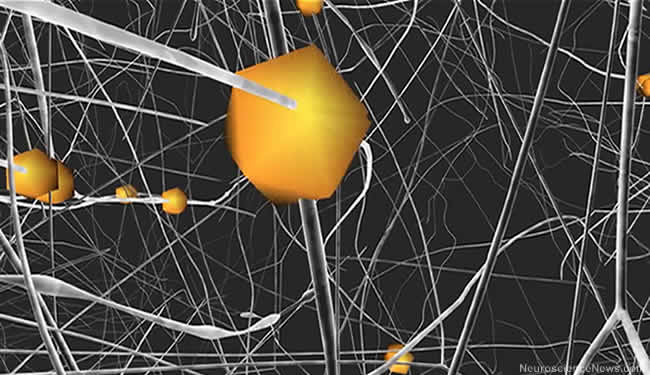Proof of concept: Researchers identify principles to support brain simulation models.
One of the greatest challenges in neuroscience is to identify the map of synaptic connections between neurons. Called the “connectome,” it is the holy grail that will explain how information flows in the brain. In a landmark paper, published the week of 17th of September in PNAS, the EPFL’s Blue Brain Project (BBP) has identified key principles that determine synapse-scale connectivity by virtually reconstructing a cortical microcircuit and comparing it to a mammalian sample. These principles now make it possible to predict the locations of synapses in the neocortex.
“This is a major breakthrough, because it would otherwise take decades, if not centuries, to map the location of each synapse in the brain and it also makes it so much easier now to build accurate models,” says Henry Markram, head of the BBP.
A longstanding neuroscientific mystery has been whether all the neurons grow independently and just take what they get as their branches bump into each other, or are the branches of each neuron specifically guided by chemical signals to find all its target. To solve the mystery, researchers looked in a virtual reconstruction of a cortical microcircuit to see where the branches bumped into each other. To their great surprise, they found that the locations on the model matched that of synapses found in the equivalent real-brain circuit with an accuracy ranging from 75 percent to 95 percent.
One of the greatest challenges in neuroscience is to identify the map of connections between neurons. In a landmark paper published in PNAS, the EPFL’s Blue Brain Project (BBP) has identified key principles that determine synapse-scale connectivity by virtually reconstructing a cortical microcircuit and comparing it to a mammalian sample. Video shared by Youtube.com user epflnews.
This means that neurons grow as independently of each other as physically possible and mostly form synapses at the locations where they randomly bump into each other. A few exceptions were also discovered pointing out special cases where signals are used by neurons to change the statistical connectivity. By taking these exceptions into account, the Blue Brain team can now make a near perfect prediction of the locations of all the synapses formed inside the circuit.
Virtual Reconstruction
The goal of the BBP is to integrate knowledge from all the specialised branches of neuroscience, to derive from it the fundamental principles that govern brain structure and function, and ultimately, to reconstruct the brains of different species – including the human brain – in silico. The current paper provides yet another proof-of-concept for the approach, by demonstrating for the first time that the distribution of synapses or neuronal connections in the mammalian cortex can, to a large extent, be predicted.
To achieve these results, a team from the Blue Brain Project set about virtually reconstructing a cortical microcircuit based on unparalleled data about the geometrical and electrical properties of neurons—data from over nearly 20 years of painstaking experimentation on slices of living brain tissue. Each neuron in the circuit was reconstructed into a 3D model on a powerful Blue Gene supercomputer. About 10,000 of virtual neurons were packed into a 3D space in random positions according to the density and ratio of morphological types found in corresponding living tissue. The researchers then compared the model back to an equivalent brain circuit from a real mammalian brain.
A Major Step Towards Accurate Models of the Brain
This discovery also explains why the brain can withstand damage and indicates that the positions of synapses in all brains of the same species are more similar than different. “Positioning synapses in this way is very robust,” says computational neuroscientist and first author Sean Hill, “We could vary density, position, orientation, and none of that changed the distribution of positions of the synapses.”
They went on to discover that the synapses positions are only robust as long as the morphology of each neuron is slightly different from each other, explaining another mystery in the brain – why neurons are not all identical in shape. “It’s the diversity in the morphology of neurons that makes brain circuits of a particular species basically the same and highly robust,” says Hill.
Overall this work represents a major acceleration in the ability to construct detailed models of the nervous system. The results provide important insights into the basic principles that govern the wiring of the nervous system, throwing light on how robust cortical circuits are constructed from highly diverse populations of neurons – an essential step towards understanding how the brain functions. They also underscore the value of the BBP’s constructivist approach. “Although systematically integrating data across a wide range of scales is slow and painstaking, it allows us to derive fundamental principles of brain structure and hence function,” explains Hill.

Notes about this neuroscience research
Written by Laura Spinney
Contact: Lionel Pousaz – Ecole Polytechnique Fédérale de Lausanne
Source: Ecole Polytechnique Fédérale de Lausanne press release
Image Source: Blue Brain Project image adapted from a still from the Youtube.com video shared by epflnews
Video Source: Blue Brain Project video from Youtube.com user epflnews.
Original Research: Research published in PNAS (Proceedings of the National Academy of Sciences) 17 September 2012 (paper is not available on the PNAS site as of this post. An update to this section will be made when it is available. You can check here for the paper.)







